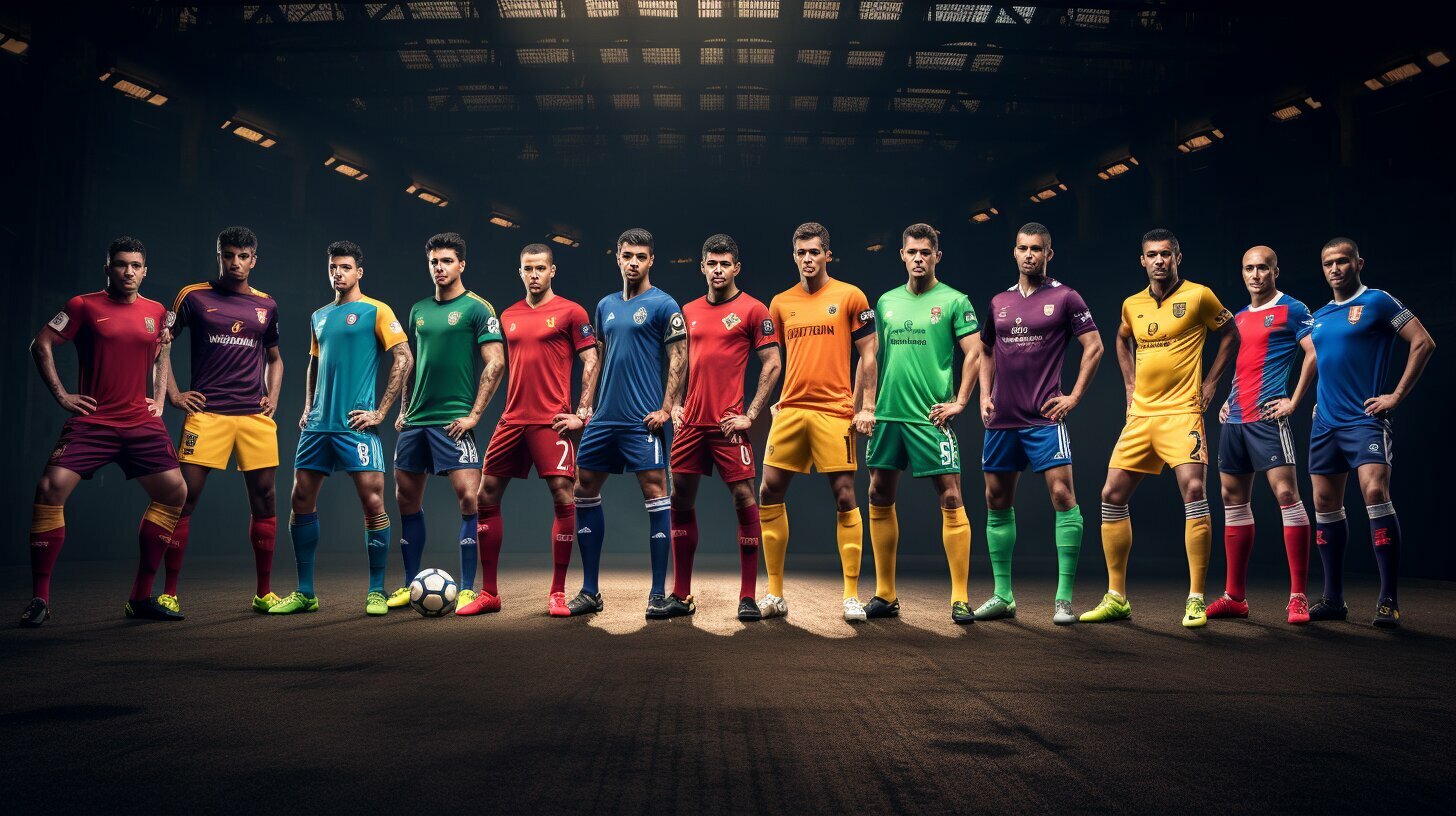Why Do Soccer Players Wear Long Socks?
Soccer players wear long socks for several reasons that contribute to their performance and safety on the field. The primary reason is to secure and protect their shin guards, which are mandatory equipment in soccer. Shin guards provide essential protection to the lower legs from kicks and tackles, and long socks help keep them in place throughout the game, reducing the risk of injury.
In addition to providing protection, long socks also play a role in maintaining team colors and keeping players’ legs warm. Matching team colors is an important aspect of soccer, and the socks contribute to the overall visual uniformity of the team. Furthermore, on colder days, long socks help keep players’ legs warm, allowing them to perform at their best on the field.
Comfort is another factor that drives soccer players to wear long socks. By ensuring a secure fit, these socks prevent the foot from sliding around inside the cleats, minimizing discomfort and maximizing performance. With a better grip and reduced foot movement, players can maintain better control over the ball and execute their moves with precision.
Key Takeaways:
- Soccer players wear long socks to secure and protect their shin guards.
- Long socks help maintain team colors and keep players’ legs warm.
- The secure fit of long socks enhances comfort and performance on the field.
- Long socks contribute to a player’s overall aesthetic and uniformity.
- It is important for soccer players to determine the ideal length for their socks.
Securing and Protecting Shin Guards
One of the primary reasons soccer players wear long socks is to secure and protect their shin guards. Shin guards are a mandatory piece of equipment in soccer, providing vital protection to the lower legs from kicks and tackles. Long socks play a crucial role in keeping the shin guards in place, preventing them from shifting during the game and reducing the risk of injury.
By wearing long socks, players can ensure that their shin guards stay securely positioned, providing maximum protection throughout the match. The tight fit of the socks helps to hold the shin guards tightly against the shin, minimizing the chances of them slipping or moving around. This added stability allows players to focus on their performance without constantly adjusting their protective gear.
In addition to their practical function, long socks also contribute to the overall aesthetic of a soccer player’s uniform. Many teams have specific colors or patterns for their socks that match their club or national team colors. By wearing long socks, players can maintain the visual unity and identity of their team, creating a cohesive and professional appearance on the field.
Furthermore, long socks provide an additional layer of warmth for players, especially during colder weather conditions. As soccer is typically played in various climates and seasons, keeping the legs warm is essential for optimal performance. The length of the socks ensures that the lower legs are adequately covered, helping to regulate body temperature and prevent muscle stiffness or cramps.
| Benefits of wearing long socks in soccer: |
|---|
| Secure and protect shin guards |
| Maintain team colors and visual unity |
| Provide additional warmth for the legs |
| Enhance player comfort and stability |
In conclusion, long socks serve multiple purposes for soccer players. They not only help secure and protect shin guards, but they also contribute to maintaining team colors, providing warmth, and enhancing player comfort and stability. The practical and aesthetic benefits of wearing long socks make them an essential part of a soccer player’s uniform.
Maintaining Team Colors and Warmth
In addition to their functional purposes, long socks also allow soccer players to maintain their team colors while providing warmth on the field. Soccer is a team sport that thrives on unity and a sense of identity. Each team typically has a specific set of colors that represent them, and these colors are proudly displayed on their uniforms, including their socks. By wearing long socks that match their team colors, players can showcase their team spirit and create a cohesive look on the field.
Furthermore, long socks provide an extra layer of warmth for soccer players during matches, particularly in cold weather conditions. As the game progresses, players may find themselves running and exerting energy, leading to an increase in body temperature. However, the legs, being further from the body’s core, are more susceptible to cooling down. Long socks help to regulate body temperature by providing insulation and preventing heat loss from the lower extremities. This added warmth can enhance comfort and minimize the risk of muscles tightening or cramping up during play.
It’s worth noting that maintaining team colors and warmth are not the only benefits of wearing long socks in soccer. They also serve a vital role in securing and protecting shin guards, as well as enhancing overall comfort and performance. The combination of functionality and aesthetics makes long socks an indispensable part of a soccer player’s attire. So, the next time you see soccer players donning their long socks, remember that there is more to it than just a fashion statement – it’s about representing their team and staying prepared for the game.
| Benefits of Wearing Long Socks in Soccer |
|---|
| Securing and Protecting Shin Guards: Long socks help keep the shin guards in place, reducing the risk of injury. |
| Matching Team Colors: Long socks allow players to showcase their team spirit and create a cohesive look on the field. |
| Providing Warmth: Long socks help regulate body temperature, keeping the lower extremities warm during matches, especially in colder weather conditions. |
| Enhancing Comfort and Performance: Long socks contribute to a secure fit, reduce foot movement within the cleats, and improve overall comfort and performance on the field. |
Enhancing Comfort and Performance
Long socks play a crucial role in providing comfort to soccer players, as they help prevent foot sliding and ensure a stable fit in the cleats. When players wear long socks, they create a barrier between their skin and the cleats, which helps to reduce friction and discomfort during intense movements on the field. The snug fit of the socks not only keeps the player’s foot in place but also helps to minimize the risk of blisters and abrasions caused by excessive rubbing.
Furthermore, long socks contribute to enhanced performance by providing additional support to the muscles in the calves. The compression-like effect of the socks helps improve blood circulation and reduces muscle fatigue, allowing players to maintain optimal performance throughout the game. With better blood flow and reduced muscle vibration, soccer players can experience increased endurance and improved agility on the field.
Additionally, long socks offer protection against external elements. When playing on turf or grass pitches, players may encounter debris or insects. Long socks act as a shield, preventing any unwanted objects from coming into contact with the players’ skin. This added protection not only ensures players’ safety but also allows them to focus solely on the game without any distractions.
| Advantages of Long Socks in Soccer |
|---|
| Prevent foot sliding in cleats |
| Provide stability and reduce friction |
| Minimize the risk of blisters and abrasions |
| Improve blood circulation and reduce muscle fatigue |
| Offer protection against debris and insects |
Determining the Ideal Sock Length
When it comes to the length of soccer socks, certain factors should be considered to determine the optimal fit for each player. The length of the socks can vary depending on personal preference, position played, and the type of shin guard being worn.
One way to determine the ideal sock length is by considering the position played. For example, defenders and midfielders may prefer longer socks that provide additional coverage and protection, while forwards and wingers may opt for shorter socks to enhance their agility and freedom of movement on the field.
Another factor to consider is the type of shin guard being worn. Some shin guards are designed to be worn beneath the socks, while others are worn on top. If you prefer wearing your shin guards beneath the socks, you may choose longer socks to ensure that the shin guards stay in place throughout the game.
Ultimately, the ideal sock length is a matter of personal preference and comfort. It’s important to choose socks that fit well, not too tight or too loose, and provide the necessary support and protection for your legs. Experimenting with different lengths can help you find the perfect balance between functionality and style.
| Factors to Consider | Ideal Sock Length |
|---|---|
| Position played (defender, midfielder, forward, etc.) | Varies based on personal preference |
| Type of shin guard (worn beneath or on top of socks) | Longer socks for shin guards worn beneath, shorter socks for shin guards worn on top |
| Comfort and fit | Socks that provide support and protection without being too tight or too loose |
Conclusion
Long socks are an essential part of a soccer player’s uniform, serving functional purposes such as securing shin guards and providing comfort, while also allowing players to showcase team colors and stay warm on the field.
One of the primary reasons soccer players wear long socks is to secure and protect their shin guards. Shin guards are mandatory equipment in soccer, offering crucial protection to the lower legs from kicks and tackles. By wearing long socks, players can keep their shin guards in place throughout the game, reducing the risk of injury.
In addition to protecting the shins, long socks also contribute to the overall aesthetic of a soccer player’s uniform. They allow players to match their team colors, creating a cohesive and professional appearance on the field. Furthermore, long socks help keep legs warm, especially in colder weather conditions, ensuring players can perform at their best.
Comfort is another important factor why soccer players opt for long socks. The socks help create a secure fit, preventing the foot from sliding around inside the cleat. This stability not only enhances comfort but also contributes to better performance on the field, allowing players to focus on their game without distractions.
In conclusion, long socks serve multiple purposes for soccer players. They protect and secure shin guards, maintain team colors, keep players warm, and enhance overall comfort and performance. So the next time you see a soccer player wearing long socks, remember that there’s more to it than just style – it’s a practical choice for the game.
FAQ
Why do soccer players wear long socks?
Soccer players wear long socks for several reasons. The primary reason is to secure and protect their shin guards. Shin guards are a mandatory piece of equipment in soccer, and they provide protection to the lower legs from kicks and tackles. Long socks help keep the shin guards in place so they don’t shift during the game, reducing the risk of injury.
Do long socks serve any other purposes?
Yes, soccer players also wear long socks to match their team colors and to keep their legs warm. The socks play a role in providing comfort by ensuring the foot doesn’t slide around inside the cleat. Overall, long socks are an essential part of a soccer player’s uniform and serve both functional and aesthetic purposes.
How long should soccer socks be?
There is no one-size-fits-all answer to this question as sock length can vary depending on personal preference and team regulations. However, most soccer players opt for socks that reach just below the knee to provide sufficient coverage for the shin guards and a comfortable fit.
Do long socks enhance soccer performance?
While long socks themselves may not directly enhance performance, they contribute to player comfort and overall performance by ensuring a secure fit and reducing foot movement within the cleats. This allows players to focus on their game without the distraction of an ill-fitting sock or sliding shin guards.
- Discovering Why Do Women Wear Lipstick: A Deeper Look - 19/12/2023
- Why Do Golfers Only Wear One Glove? - 16/12/2023
- Why Don’t Hobbits Wear Shoes? - 14/12/2023
Hi, I’m Rhiannon, the lead author behind The News Wire. As a passionate journalist, I strive to bring you the latest news and updates from all over the world. With a keen eye for detail and a dedication to unbiased reporting, I aim to deliver well-researched and informative articles that keep you informed and engaged. From breaking news to in-depth analyses, I cover a wide range of topics with the aim of keeping you in the loop. Join me on The News Wire as we explore the dynamic and ever-changing landscapes of global events, uncovering the stories that matter most.






